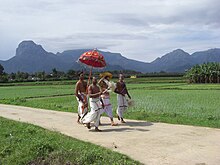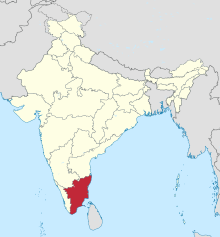Tamil Brahmins
Tamil Brahmins are members of the caste of Brahmins that the ethnicity of Tamils belong.
Demographics
Distribution and number
The Tamil Brahmins originally come from the southern Indian state of Tamil Nadu . Due to migration, many Tamil Brahmins also live in other parts of India as well as abroad.
The number of Tamil Brahmins is difficult to quantify because the Indian census has not collected any caste data since 1931. In 1931, the Brahmin population in the Tamil districts of the Madras presidency at that time (largely congruent with today's state of Tamil Nadu) was 2.5 percent, including 1.9 percent Tamil and 0.6 percent other (mainly Telugu-speaking ) Brahmins. If the numbers from 1931 are extrapolated to the current population, the number of Tamil Brahmins in 2011 can be estimated at around 1.85 million. An estimated 75 percent of Tamil Brahmins live in Tamil Nadu state (mostly in cities, especially the capital Chennai ), 20 percent in other parts of India (mostly in large cities like Bangalore , Mumbai, and Delhi ), and 5 percent abroad.
In Sri Lanka , unlike in India, the Tamil Brahmins hardly play a role. Among the Tamil population of Sri Lanka (see Sri Lankan Tamils ), Brahmins are practically non-existent, apart from a numerically small group of temple priests. Brahmins make up less than one percent of the population on the Jaffna Peninsula in northern Sri Lanka. The Brahmins are even less numerous in the Batticaloa region on the east coast, where even the temple priests belong mainly to non-Brahmanic castes.
Subgroups

|

|
|
|
Traditionally, the Aiyar and Aiyangar differ in the forehead signs ( tilaka ) they wear. Left an aiyar, right an aiyangar.
|
||
The Tamil Brahmins are divided into two subgroups: the Aiyar (Iyer) and the Aiyangar (Iyengar). The Aiyar belong to the Smarta tradition of Hinduism , while the Aiyangar are Vishnuits . The Aiyar are divided into four sub-castes (Vadama, Brahmacharanam, Ashtasahasram and Vattima), the Aiyangar into two sub-castes (Vadakalai and Thenkalai). Traditionally these sub-castes were endogamous , but today marriages between Tamil Brahmins of different sub-castes are not uncommon. In the past, Tamil Brahmins carried the caste names Aiyar or Aiyangar (sometimes other names such as Acharya or Sastri ) as their surname . However, since the mid-20th century, the use of box-based surnames in Tamil Nadu has become uncommon.
No data has been collected on the subcastes of the Tamil Brahmins since the Indian census in 1891. However, their relative proportions are likely to have remained fairly stable. In 1891 the Aiyar made up 68 percent and the Aiyangar 32 percent of the Tamil Brahmins.
history
Since when there have been Brahmins in Tamil Nadu cannot be said. What is certain, however, is that Brahmins are mentioned in the ancient Tamil sangam literature , which probably originated in the first centuries AD. They are called Andanar ( அந்தணர் antaṇar ) or Parppar ( பார்ப்பார் pārppār, "seer", today a pejorative term for Brahmins). From the Sangam texts it can be concluded that the Brahmins had a close relationship with the kings and enjoyed high social recognition. Elements of the Brahmanic culture from Northern India such as the Veda recitation or the Vedic sacrificial ritual are mentioned several times .
Position in the caste system
In the classical Hindu concept, society is divided into four hierarchical classes ( Varnas ) - Brahmins, Kshatriyas , Vaishyas and Shudras - as well as the “untouchables” ( Dalits ) outside the caste system . However, in South India the two middle classes of the Kshatriyas and Vaishyas are practically not represented, so that all non-Brahmanic castes are classified as Shudras. Of the four classes, the Brahmins occupy the highest position. However, the position of the Tamil Brahmins was never as dominant as the Varna model suggests, since land-owning non-Brahmins such as the Vellalar also exerted great influence in the premodern agrarian society . Also, the Varna model does not play a major role in the Tamil caste system, as most non-Brahmans oppose a Shudra identity. Instead, a specifically non-Brahmanic identity developed during the colonial period, so that today in Tamil Nadu a general distinction is made between Brahmins, non-Brahmans and Dalits (as well as Christians and Muslims ).
Culture
Clothing and hairstyle

The Tamil Brahmins traditionally differentiate themselves from members of other castes through a number of customs. The most important sign of belonging to the Brahmin caste is the sacred cord that Brahmin men wear over their left shoulder after their initiation. In the past, the Tamil Brahmins also had special hairstyles and clothes. In contrast to non-Brahmans, Brahmin men shaved the front part of their head and tied the remaining hair in a topknot ( Shikha ). They also tied their leg robes ( Veshti ) between their legs in a special way, while the non-Brahmins simply wrapped it around their waist. Likewise, the Brahmin women wore longer and differently wrapped saris than non- Brahmin women. Today most Tamil Brahmins, except for priests at work, have given up the traditional costume. Unlike in the past, when South Indian men did not wear shirts, but only a scarf around their shoulders, the sacred cord is usually not visible today, so that Tamil Brahmins can not be distinguished from non-Brahmans outwardly.
food
Like the vast majority of Brahmin groups across India, the Tamil Brahmins are traditionally vegetarians . Although some Orthodox non-Brahmins (especially among the Vellalar ) are vegetarians, most non-Brahmans eat meat just like the Christians and Muslims in Tamil Nadu, so that vegetarianism is an important distinguishing feature between Brahmins and non-Brahmins. Vegetarianism means giving up meat, fish and eggs. Some other foods like onions and garlic are frowned upon, as is alcohol . According to traditional purity regulations, Brahmins are only allowed to consume food that has been prepared by other Brahmins. Today not all brahmins strictly obey these rules.
Since the early 20th century, coffee consumption spread among the Tamil, especially the Tamil Brahmin, middle class. Drinking coffee is therefore an important part of everyday Tamil-Brahmin culture.
Individual evidence
- ↑ CJ Fuller and Haripriya Narasimhan: Tamil Brahmans. The Making of a Middle-Class Caste, Chicago / London: University of Chicago Press, 2014, pp. 231–232.
- ↑ Jakob Rösel: Shape and emergence of Tamil nationalism, Berlin: Duncker & Humblot, 1997, pp. 174–176.
- ^ Dennis B. McGilvray: Crucible of Conflict. Tamil and Muslim Society on the East Coast of Sri Lanka, Durham / London: Duke University Press, 2008, pp. 84–86.
- ↑ Fuller & Narasimhan 2014, p. 6.
- ↑ George L. Hart: The Poems of Ancient Tamil. Their Milieu and their Sanskrit Counterparts, Berkley, Los Angeles: University of California Press, 1975, pp. 51-56.
- ^ Marguerite Ross Barnett: The Politics of Cultural Nationalism in South India, Princeton, New Jersey: Princeton University Press, 1976, pp. 15-17.
- ↑ Fuller & Narasimhan 2014, pp. 6-7.
- ↑ Fuller & Narasimhan 2014, p. 13.
- ↑ Fuller & Narasimhan 2014, pp. 7–8.
- ↑ AR Venkatachalapathy: “'In Those Days There Was No Coffee'. Coffee Drinking and Middle-Class Culture in Colonial Tamil Nadu ”, in: In Those Days There Was No Coffee. Writings on Cultural History, New Delhi: Yoda Press, 2006, pp. 11–31.
literature
- CJ Fuller and Haripriya Narasimhan: Tamil Brahmans. The Making of a Middle-Class Caste. Chicago / London: University of Chicago Press, 2014.

